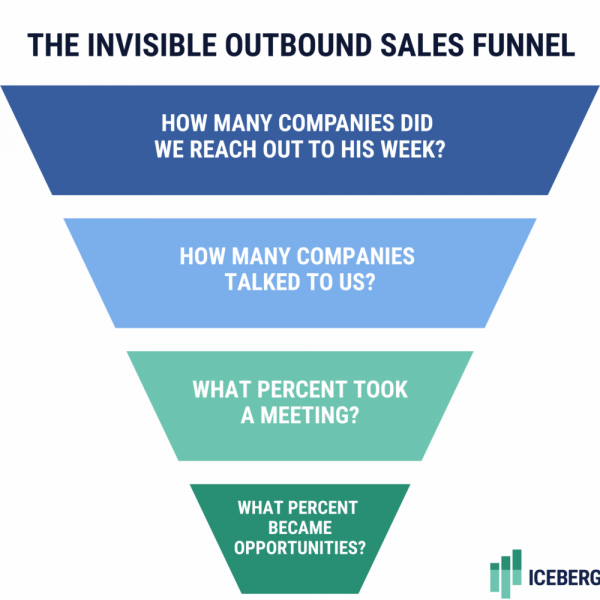Today’s tools make it all too easy for sales development leaders to measure the wrong metrics in outbound sales.
Outbound is an activity-centric sales motion. Leaders typically focus on performance metrics like total number of cold calls, emails sent, and meetings booked. These numbers are used to measure rep performance, along with metrics like email open rates.
We measure calls, emails, and meetings because they’re easy. These aren’t bad, but they don’t tell the whole story.
In B2B, companies sell to companies. A single purchase decision requires buy-in from stakeholders across the organization. With so many people involved, company-level activities in outbound sales matter just as much—if not more—than standalone activities.
Why measuring outbound sales activities is not enough: A tale of two sales reps
Imagine you have two sales reps.
Both make 100 calls, send 100 emails, and reach out to 50 people this week. Both create two new opportunities to send to your AEs.
Rep #1 reached out to one person at 50 different companies.
Rep #2 reached out to 2 companies, 25 people each, both from Fortune 1000.
Based on the number of calls, emails, and opportunities created, these reps look like they had the same week. But the opportunity value created by Rep #2 is much, much higher than Rep #1. We miss this important difference by only looking at single metrics in a vacuum.
“How many companies do I need to reach out to create X dollars of pipeline for the sales team?”
If you don’t know your way around Salesforce, you might think there are fields to help answer this question fairly quickly.
Spoiler alert: It’s actually quite challenging to access company data in a single record.
That’s because an outbound motion is spread across five (five!) objects in Salesforce.
- Accounts
- Contacts
- Opportunities
- Activities (meetings, calls)
- Events
Unless sales development leaders build custom solutions to aggregate data at the company level, it’s impossible to translate outbound effort into pipeline creation without significant manual effort.
The Invisible Outbound Sales Funnel
It’s easy and understandable for sales development to be distracted by standalone activity metrics. We focus on the data we have.
But to 1) get to the core of who your best and weakest sales reps are, and 2) know how efforts correlate to pipeline generated, we have to ask the right questions and put activities in the context of companies.
The Invisible Outbound Sales Funnel is invisible because it’s difficult to measure. Accessing meaningful outbound sales metrics requires custom code, even in commonly used sales and marketing tools.
Use this funnel as a guide for building the data infrastructure for meaningful outbound sales reports. These are the questions sales development leaders should be able to answer quickly to lead a successful outbound sales team.
- How many companies did we reach out to this week?
- Of those, how many companies talked to us?
- Of those, what percentage took a meeting?
- Of those, what percentage became opportunities?
Knowing the answer at each stage of the invisible funnel enables sales leaders to set targets for company outreach that tie back to pipeline.
Knowing your numbers also allows you to understand the nuances of your own market. For example, we’ve seen companies with outbound sales motions experience success with far fewer touches than well-worn industry assumptions.

Get help with outbound sales metrics
Iceberg’s team of RevOps specialists owns the strategy and execution of critical sales & marketing operations projects so startups can scale faster with the right resources for a fraction of the cost of a full-time hire.


